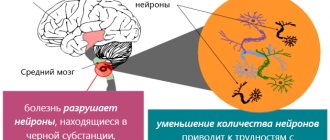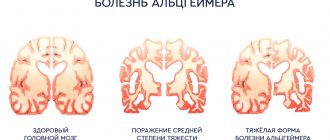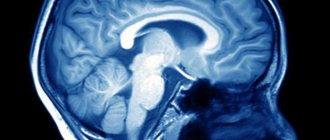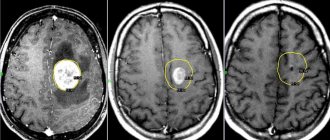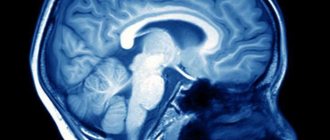A malignant brain tumor, often called brain cancer, is a neoplasm of modified cells that is characterized by relatively rapid growth and the ability to grow into neighboring tissues and other organs. This is an extremely dangerous pathology, since at an early stage, when it is quite easy to cope with, it is discovered only as a result of special studies. The disease can develop in a person of any age and gender; even cases of congenital neoplasms have been reported. As the tumor grows, it takes up more and more space in the skull, which leads to compression of other tissues and a gradual increase in intracranial pressure. Therefore, even a benign cell formation over time acquires a malignant course and can lead to death.
Kinds
Based on the method of tumor formation, oncologists distinguish between brain cancer:
- primary – formed directly from cells belonging to the organ;
- secondary, or metastatic - occurs when metastases from other organs of the body penetrate into the skull.
Primary neoplasms occur 3-4 times less frequently than secondary ones and account for approximately 1.5% of all cases of cancer. The overall incidence of cerebral tumors is 5-6%, and the risk of their development increases with age. In children, this disease is extremely rare - statistics record no more than 2.4 cases per 100 thousand population under the age of 18 years.
Depending on what tissue became the source for the neoplasm, the following types are distinguished.
- Astrocytomas (gangliomas), which develop directly in brain cells and account for up to 80% of all clinical cases.
- Meningiomas, the source tissue for which is the membranes of the brain, and their cells rarely acquire malignant characteristics, although the growth of tumors in any case negatively affects the functioning of the brain.
- Neuromas that grow from the myelin sheath of nerve fibers inside the skull.
- Pituitary adenomas form in the tissue of the pituitary gland and exhibit malignant features in rare cases.
Causes of brain tumors in adults
Scientists have not yet determined the exact cause of tumors, but there are assumptions about the connection of their growth with the effects of radioactive radiation, toxins penetrating the body, and environmental pollution.
Children may develop congenital neoplasms - one of the reasons is considered to be intrauterine development disorders. A possible factor may be traumatic brain injury, which can also intensify an already existing process.
There is evidence that some brain tumors can develop after radiation therapy prescribed for the treatment of other pathologies, immunosuppressive treatment, and HIV infection. There is a hereditary predisposition to certain types of brain cancer. But for many people the cause remains unknown.
About 10 - 30% of brain tumors are of metastatic origin - these are cells that are carried by the blood flow (less often lymph) into the brain vessels, tissues, and membranes. About 60% of such tumors are multiple.
Most often it metastasizes to the brain:
- in men – lung damage, colorectal cancer, kidney damage;
- in women - breast cancer, melanoma, colorectal and lung cancer.
Intracerebral metastases occur with cancer of the uterus, digestive tract or prostate.
Symptoms
Signs of brain cancer are divided into general cerebral, i.e. manifested in all types of disease without exception, and focal ones, from the totality of which one can form a primary idea of the localization of the neoplasm.
Common symptoms of a brain tumor that appear as a result of increased intracranial pressure include:
- the appearance of constant headaches, which intensify with sudden movements of the head and are not relieved by medications;
- sudden dizziness, nausea and vomiting, fainting;
- feeling of constant fatigue, drowsiness;
- the appearance of problems with visual perception – blurred pictures, “sights”, hallucinations;
- violation of spatial orientation and coordination.
In turn, focal symptoms of brain cancer depend on the location of the tumor and allow localization of the pathology:
- in the forehead area - due to weakening of one half of the body, loss of smell, change in the patient’s character;
- in the temple area - for convulsions, speech disorders, developing forgetfulness;
- in the crown area - for speech impairment, loss of sensitivity of half the body;
- in the occipital lobe - due to loss of vision in one of the eyes;
- in the cerebellum - by vibration of the eyeball, lack of coordination of movements, spasm of the neck muscles;
- in the brain stem - due to unsteadiness of gait, disturbances in swallowing and difficulty speaking, weakness of the facial muscles.
In order not to miss the onset of the disease, if even one or two of the first signs of brain cancer appear, you must consult a neurologist and undergo an examination.
Signs of a brain tumor in adults
Focal symptoms are often among the first to appear.
They arise due to the pressure of the tumor on the surrounding tissues and chemical reactions to foreign cells, hemorrhages, blockage of blood vessels with a tumor embolus, compression of tissues and nerves. As the tumor grows, symptoms from neighboring areas appear, then general brain symptoms. If the tumor is large, a so-called mass effect may occur (the main structures of the brain are displaced, causing the cerebellar region to become wedged into the opening of the skull). One of the early signs is headache. It is usually local and occurs due to irritation of blood vessels, nerves, and meninges. There may be diffuse pain throughout the head, which is typical of meningeal lesions. The nature of the pain is paroxysmal, deep, intense or bursting.
Another sign is vomiting, which is not associated with food intake. It may or may not be at the peak of the headache.
Dizziness occurs in the form of dips, rotation of the body or objects around.
Possible muscle weakness, muscle hypertonicity, uneven on one and the other side of the body, changes in tendon reflexes. Muscle-joint sensations may also suffer - sensations during movement, pressure, vibration.
For many tumors, convulsive syndrome is typical - sometimes it becomes the first sign of brain damage. There may be absence seizures or tonic-clonic seizures, Jacksonian epilepsy. Some people also experience an aura before attacks. As the tumor grows, there may be partial seizures or decreased activity of the lesions.
Some people may have mental disorders. Sloppiness, lack of initiative, aggression, euphoria or causeless gaiety, apathy, complacency can also be signs of brain damage. Tumor growth increases the severity of symptoms. Visual hallucinations, severe memory disturbances, attention problems and thinking problems may occur.
Possible problems with vision, congestion in the area of the optic nerve - these are floaters before the eyes, blurred vision, fog, blurred vision. Fields of vision may be lost.
Additionally possible:
- hearing loss;
- aphasia;
- ataxia;
- eye movement disorders;
- hallucinations (auditory, gustatory);
- autonomic dysfunctions.
If the hypothalamic-pituitary region is affected, hormonal metabolism suffers.
Causes and risk factors
As medical practice shows, the main cause of brain cancer is metastasis from other organs affected by the disease. For primary neoplasms, risk factors have been identified that increase the incidence of pathology:
- old age – 50 years and above;
- having a close relative with a brain tumor;
- negative impact of radioactive exposure;
- genetic pathologies;
- prolonged contact with certain chemicals;
- brain injury or concussion.
Having one or more of these symptoms does not mean that you will definitely get sick. However, in this case it is necessary to be especially careful and undergo examination if warning symptoms appear.
Stages
Cancer specialists distinguish four main stages characteristic of brain cancer.
- A small number of cells are affected, the size of the neoplasm is small, but it is already beginning to have an effect, expressed by a feeling of weakness, drowsiness, and periodic headaches without clear localization. If you do not neglect these symptoms of early stage brain cancer and undergo examination, then the detected tumor is cured in almost one hundred percent of cases.
- The tumor grows and spreads to neighboring tissues that are located next to it. Symptoms intensify, become more pronounced and noticeable. Some patients already at this stage develop convulsions and seizures similar to epileptic ones. The chances of successful surgical treatment remain, although not to the full extent.
- The growth of the tumor accelerates, it grows into healthy tissue, and there is a threat of death. A characteristic sign of the third stage is nystagmus - constantly moving pupils. There is a high probability that the tumor will be recognized as inoperable, in which case the patient receives only symptomatic treatment.
- The tumor affects all brain tissue located near it and rapidly increases in size. The patient's condition deteriorates sharply, possibly falling into a coma. At this stage, surgery to remove the pathological formation is impossible, and the prognosis is unfavorable. Therapy is aimed only at alleviating the patient's suffering.
In primary brain tumors, there are no metastases to other organs. A secondary disease most often develops due to the patient’s existing melanoma, kidney cancer, sarcoma, or colon tumor that metastasizes to the brain.
Stages of brain tumor in adults
A typical stage for a cancerous lesion determines treatment options, prognosis, and typical signs and symptoms.
There are 4 stages in total - from the mildest to the extremely severe. The first stage is when one of the parts of the brain is affected by a small neoplasm, a nodule, there is no penetration into neighboring tissues, there is no pressure on the surrounding areas of the brain.
The second stage - the tumor grows slowly, but there is penetration into neighboring areas;
The third stage - the tumor changes its structure, cells divide faster, neighboring sections and tissues grow;
Stage four – the tumor is large, grows into neighboring brain structures, and distant metastases are possible.
Diagnostics
As a rule, diagnostic examinations for brain oncology are carried out as follows. You come for a consultation with a neurologist, who listens to complaints, conducts an examination and prescribes instrumental studies.
- CT scan of the head, which detects the presence of neoplasms already at the first stage.
- MRI of the brain with contrast, which is performed for early detection and localization of cancer.
- Angiography, which reveals abnormalities in the structure of the blood vessels of the brain.
- Scintigraphy, or radioisotope contrast study, is effective for the early detection of tumors.
- Lumbar puncture, through which a sample of tumor tissue is obtained for subsequent analysis.
The types of studies are selected by the doctor depending on the symptoms. The totality of the data obtained allows not only to identify a tumor, but also to accurately localize it, determine the size and stage of development of the disease, which is important for determining subsequent actions.
Prognosis for brain cancer
If a tumor is detected at an early stage of development, after which the correct complex treatment (surgery, radiotherapy and chemotherapy) is selected, more than 60% of patients can be saved. Late stages of brain cancer or inoperable tumors allow only 30% of patients to survive more than 5 years. However, some types of tumors are more aggressive - glioblastoma reduces the chance of five-year survival to 5%, but some patients can live with the disease for years. Therefore, it is simply unrealistic to accurately predict how long a patient will live after diagnosis. Even in case of successful treatment, a person after brain cancer remains at risk, because the tumor can recur.
Treatment
Since the brain is an extremely specialized organ, treatment of tumors is the prerogative of a neurologist or neurosurgeon if it is decided that surgery is necessary. The choice of method depends on the location of the pathological formation and the stage of its development.
- Surgical intervention allows you to completely get rid of the disease only in some cases, when the tumor is located in a place convenient for penetration and affects a minimum of tissue. More often, surgery is performed to reduce the severity of symptoms.
- Chemotherapy can be administered not only to adults, but also to children; drugs are administered orally or by injection.
- Radiation therapy is usually needed to remove any remaining tumor that cannot be removed during surgery.
- Corticosteroids are prescribed to reduce tissue swelling and inflammation. They have no effect on malignant cells.
- Symptomatic medications, which include painkillers, anticonvulsants and antidepressants, are prescribed to make the patient feel better and reduce symptoms.
Rehabilitation
To return the patient to a normal lifestyle after treatment, the doctor may prescribe rehabilitation procedures depending on the nature and extent of brain damage.
- Physical therapy is necessary to restore motor coordination and muscle strength.
- Classes with a speech therapist are useful for speech disorders.
- Treatment by a psychologist or psychotherapist is required for patients with developed depression, memory and thinking disorders.
- Taking anticonvulsant medications to prevent epileptic seizures.
After completing treatment, you must remember that brain tumors can recur, and you need to undergo regular preventive examinations.

